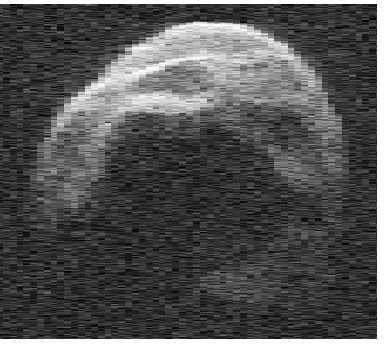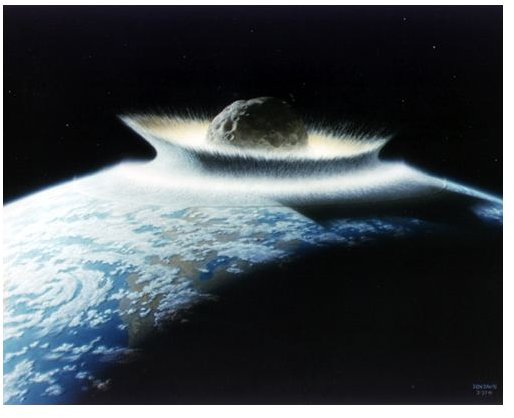Methods to Avoid Asteroid Collisions and How NASA Tracks Near-Earth Asteroids to Asses Risks of Each Object
Avoiding a Head-On Collision
The best way to avoid a real-life version of the movie “Armageddon” would be to push the approaching Near-Earth Object (NEO) enough to speed it up, slow it down or alter its path, any of which could change an extinction-class collision into a merely scary near-collision. NASA scientists offer two options for doing so: an “impulsive” (as in explosion) approach or a slow-push one.
In the impulsive category, a nuclear bomb has the best potential for deflecting a dangerous asteroid or comet.
“Because of the large amount of energy delivered, nuclear devices would require the least amount of detailed information about the threatening object, reducing the need for detailed characterization,” stated a March 2007 NASA report (“Near-Earth Object Survey and Deflection Analysis of Alternatives”) to Congress. Detonating a nuke on or below the object’s surface would pack the most punch – anywhere from 10 to 100 times more energy than would an above-surface blast. However, NASA added, an above-surface bomb would be less likely to break the NEO into pieces … something to avoid, because that would mean many smaller but equally dangerous pieces of comet or asteroid still on a collision course with Earth.
Taking aim at a dangerous space object with a nuclear device would require not only fast action but international cooperation, too. Without prior OK from world powers, the approach could violate the Treaty on Principles Governing the Activities of States in the Exploration and Use of Outer Space, including the Moon and Other Celestial Bodies.
An A-bomb isn’t the only impulsive option, though. NASA’s also explored the possibility of using conventional explosives or some kind of asteroid-aimed “bullet” that could hit an NEO at high speed to alter its path. All those alternatives wouldn’t deliver nearly as much firepower as a nuke, though, and would probably have to be much more powerful than needed just in case the approaching object is denser or bigger than scientists thought.
“(K)inetic impacts are … sensitive to the porosity, elasticity, and composition of the target and may require large performance margins if these characteristics are not well determined,” the NASA report stated.
Pictured on the left is the Meteor Crater in Arizona, believed to have be caused by an 80-foot-diameter asteroid that struck between 20,000 and 50,000 years ago.
Image credit: https://neo.jpl.nasa.gov/images/meteorcrater.jpg
Potentially Hazardous Asteroid

This image by Lance Benner of the Jet Propulsion Laboratory shows Asteroid 1999 JM8, “the largest of the so-called potentially hazardous asteroids ever studied in detail.”
Image credit: https://neo.jpl.nasa.gov/images/jm8_aug2.gif
The Slow-Push Option
A powerful blast of some kind would be the way to go in a t-minus not-very-much situation, in which humanity might have only a few months or years to head off disaster. For an oncoming object with a larger window of preparation time, though, a slow-push deflection could also work.
The NASA report highlights several slow-push methods, but points out all would be effective in only a few cases … probably fewer than 1 percent of potential threats. Another downside to the slow-push approach is that all of the options are probably years from being technologically feasible.
“In general, the slow push systems were found to be at a very low technology readiness level and would require significant development efforts,” the report stated.
Among the slow-push options: using solar energy or a pulsed laser to heat an NEO and “boil off” material; landing a craft on the NEO that would mine material from the object then blast the material off at high speed to shift the NEO’s path; using gravity or tugging to change the NEO’s trajectory; or changing the albedo of the NEO to take advantage of the Yarkovsky effect (a photon-driven force that acts on a rotating body).
Earth Impact

NASA artist Don Davis’ depiction of a 500-kilometer-diameter asteroid colliding with an early Earth.
Image credit: https://solarsystem.nasa.gov/multimedia/display.cfm?IM_ID=2304
“A Long Lead Time or None at All”
While all the previous NEO-deflection options are possibilities, none of them exists in real life today. How much of a cause for concern is that? Probably not too much.
Most of the potential impact risks identified by NASA’s Jet Propulsion Laboratory’s Sentry System (which scans for possible dangers 100 years into the future) seem scariest when a new NEO is first found. Once researchers can observe and track the potential hazard for a while, they’re able to fine-tune their orbital calculations … and that’s usually enough to determine the object isn’t in danger of crossing Earth’s path. That’s why the lists of potentially hazardous objects from Sentry and NEODyS (Near Earth Objects Dynamic Site, another NEO tracking program) regularly change.
Still, scientists remain well aware that there are lots of objects out there they haven’t identified and tracked or, more worrisome still, objects they have identified but later lost track of. When it comes to potentially hazardous NEOs, it’s best to know where they all are and where they’re going … something researchers are working on, but haven’t yet fully achieved.
“With so many of even the larger NEOs remaining undiscovered, the most likely warning today would be zero – the first indication of a collision would be the flash of light and the shaking of the ground as it hit,” writes David Morrison, senior scientist for the Astrobiology Institute at NASA’s Ames Research Center. “In contrast, if the current surveys actually discover a NEO on a collision course, we would expect many decades of warning. Any NEO that is going to hit the Earth will swing near our planet many times before it hits, and it should be discovered by comprehensive sky searches like Spaceguard. In almost all cases, we will either have a long lead time or none at all.”
Resources
Following are several resources with more information about our efforts to find and track potentially hazardous NEOs:
Sentry at https://neo.jpl.nasa.gov/risk/
NEODyS at https://newton.dm.unipi.it/cgi-bin/neodys/neoibo
Ames Research Center at https://www.nasa.gov/centers/ames/home/index.html
Spaceguard at https://www.esa.int/esaMI/NEO/SEMS58OVGJE_0.html
Earth Impact Effects Program, Arizona University at https://www.lpl.arizona.edu/impacteffects/
This post is part of the series: NEO’s - Near Earth Objects and the Hazards They Represent
This two part series discusses what objects are out there that we need to be concerned with and how we identify them. The second part of the series looks at the consequences of an impact.
